Riding The Profitable Wave, Stocks Secular Bull Market?
Stock-Markets / Stocks Bull Market Nov 28, 2013 - 09:05 AM GMTBy: Puru_Saxena
 BIG PICTURE – The world’s economy is growing at a tepid pace and the majority of central banks are pursuing expansionary monetary policies. Furthermore, the central banks of the developed world are engaged in unprecedented asset purchases and it appears as though this ‘stimulus’ will continue for the foreseeable future.
BIG PICTURE – The world’s economy is growing at a tepid pace and the majority of central banks are pursuing expansionary monetary policies. Furthermore, the central banks of the developed world are engaged in unprecedented asset purchases and it appears as though this ‘stimulus’ will continue for the foreseeable future.
Today, the US unemployment rate is well above the Federal Reserve’s target rate of 6.5% and the official Consumer Price Index is below the 2% level. Under these circumstances, it is hardly surprising that the Federal Reserve is continuing with its US$85 billion per month bond buying program.
At this stage of the cycle, it is impossible for anybody to guarantee when the dreaded ‘tapering’ will begin. However, we are of the view that the Federal Reserve will probably stay the course until next summer. Furthermore, we suspect that the Federal Reserve will withdraw its QE program in a gradual manner and if the US economy continues to improve, ‘stimulus’ may end by the end of 2015. Conversely, if the world’s largest economy slows down or slips into a recession, then the QE initiative will not be reduced or withdrawn.
Turning to the financial markets, it is notable that the bellwether S&P500 Index has now climbed to a record high and the primary trend is firmly up. More importantly, the S&P500 Index has only recently broken out of a 13-year trading range (Figure 1) and this has bullish implications. Remember, throughout recorded history, such breakouts following a lengthy trading range have always been followed by a multi-year secular bull market. Therefore, unless ‘this time is different’, Wall Street’s primary trend should remain up for years.
Figure 1: S&P500 Index – secular bull market?
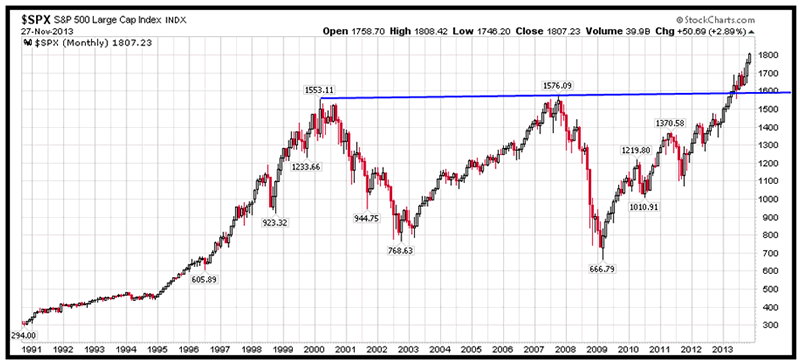
Source: www.stockcharts.com
For sure, the ongoing uptrend will be punctuated by periodic corrections, but we suspect that a major bear market will not arrive as long as the Fed Funds Rate remains unchanged. After all, with interest rates near historic lows, investors are desperately searching for a real return on their capital and this urge will support asset prices.
At some point in the future, QE will be withdrawn and the Fed Funds Rate will increase in baby steps. It goes without saying, these developments will be bearish for financial assets but we are not there yet.
In the meantime, America’s housing market is improving and it is conceivable that home prices may rise for several years. Undoubtedly, this trend will provide a massive tailwind to the world’s largest economy and on the back of rising home prices, millions of Americans will ramp up their consumption.
If you review Figure 2, you will note that American housing is now extremely affordable and the typical household can easily make the monthly mortgage payment on a home. Thanks to historically low interest-rates, fixed rate mortgages have become affordable for American families and we suspect that this cheap credit will fuel another housing boom.
Figure 2: US housing is affordable
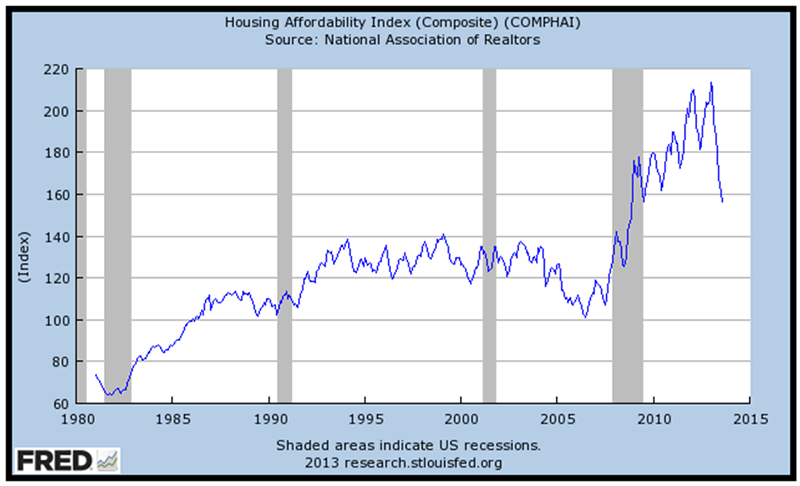
Source: St. Louis Fed
If our assessment turns out to be correct, American home prices will appreciate over the next 4-5 years and this will benefit the world’s largest economy. Remember, the housing industry is labour intensive and prosperity in this sector will help bring down the unemployment rate. More importantly, rising home prices will create the ‘wealth effect’ and encourage Americans to unleash their pent-up demand.
The above developments will probably have a profound impact on business activity and rising corporate earnings will support the American stock market. Accordingly, we are maintaining our over-weight exposure to US equities and unless monetary tightening occurs, we will continue to ride the profitable wave.
In addition to America, we believe that the stock markets of Europe and Japan will also perform well, thereby rewarding long-term investors. Therefore, for the first time in years, we have allocated some capital to these regions.
Finally, in terms of sectors, we believe that banks, biotechnology, consumer discretionary, consumer staples, transportation and technology stocks will continue to perform well. Furthermore, after several years of disappointing performance, it is conceivable that the pharmaceutical stocks may provide outsized returns.
If you review Figure 3, you will see that after a 10-year base building period, the Dow Jones US Pharmaceuticals Index has recently broken through the 300-305 area and by doing so, it has shown tremendous strength.
Figure 3: Dow Jones US Pharmaceuticals Index
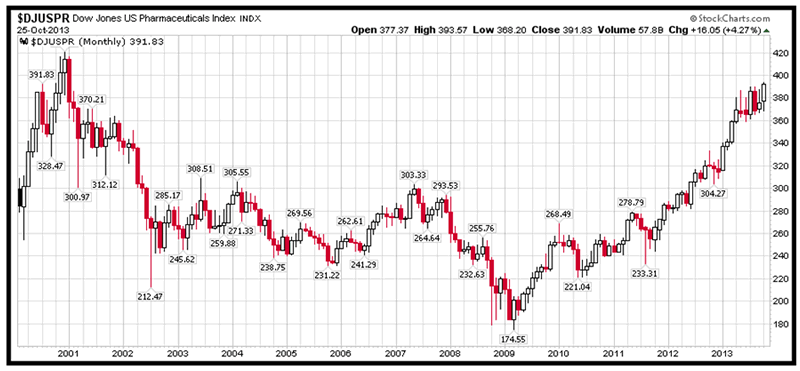
Source: www.stockcharts.com
Although there are no guarantees in this business, we are of the view that the ageing population in the West will bring about a period of prosperity for the dominant pharmaceutical firms.
In terms of fundamentals, there can be no doubt that the healthcare companies generate some of the most consistent cash flows and their products are always in demand. Moreover, some of the leading stocks in this sector offer attractive dividend yields, thereby making them a viable holding for the ‘buy and hold’ investor.
Bearing in mind the above, we have positioned our equity portfolio in some of the leading stocks from the favourable sectors. Furthermore, we have also invested our fund portfolio in our preferred geographical areas and industry groups.
Given the fact that the markets are trending higher, we are currently fully invested. Nonetheless, we are monitoring the price action very closely and if the situation deteriorates, we will take evasive action.
COMMODITIES – After surging for a decade, the prices of commodities peaked in April 2011 and since then the sector has been in a relentless downtrend.
You will recall that the commodities’ primary uptrend commenced in 2001 and for 10 years, prices rose at an unprecedented rate. Thanks to the housing boom in the West and the astonishing construction bonanza in China, the prices of various commodities went through the roof! Unsurprisingly, the bull market was temporarily interrupted by the global financial crisis, but due to China’s ‘stimulus’, the rally soon resumed and prices eventually surpassed the levels reached in 2008.
As you can see from Figure 4, after a massive advance which lasted for several months, the Reuters-CRB (CCI) Index finally peaked in April 2011. Furthermore, you will note that since topping out 2½ years ago, this index has been in a relentless downtrend and each rally attempt has failed beneath the previous high (blue arrows on the chart). Last but not least, Figure 4 reveals that this bellwether index is currently trading below the 40-week moving average (dashed line on the chart). Thus, whichever way you look at it, the trend in commodities is clearly down.
Figure 4: Reuters-CRB (CCI) Index
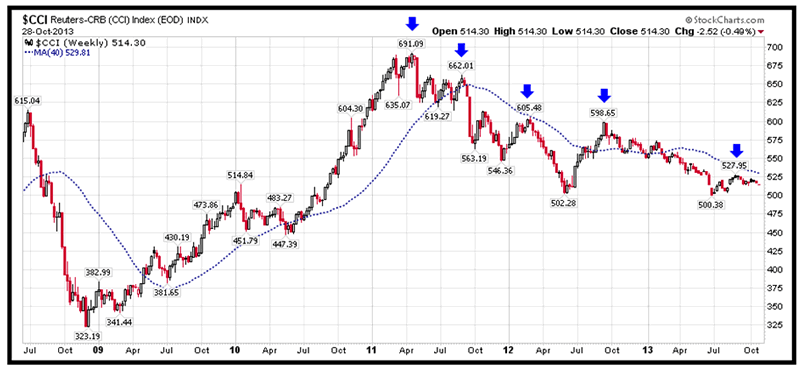
Source: www.stockcharts.com
From a fundamental perspective, it is interesting to note that the top in commodities coincided with the peak in China’s economic momentum. Therefore, it is conceivable that as long as the world’s second largest economy continues to experience a slowdown, the prices of commodities will remain depressed.
At this stage of the game, nobody knows how this will play out. However, we suspect that China’s excesses will be corrected in the future. In other words, it is possible that China’s frothy real-estate sector may experience a hard landing and this will put additional downward pressure on the industrial commodities.
Whether you agree with us or not, the fact is that China’s fixed-asset investment boom is unsustainable and at some point, property (un)affordability will revert to the historical mean. When that happens, the prices of various commodities will probably plummet and the related mining and construction companies will feel the heat.
Although we do not possess a crystal ball, we suspect that the industrial metals will be the hardest hit and the related miners may experience a gut-wrenching contraction in business activity. Furthermore, the ancillary businesses which are currently profiting from China’s construction boom may also be affected by the inevitable hangover.
If our assessment proves to be correct and China’s construction bubble pops, the price of copper will plunge and it may approach levels last seen during the depth of the global financial crisis.
In fact, if you review Figure 5, you can clearly see that copper has been in a persistent downtrend since early 2011 and similar to the Reuters-CRB Index, it is also trading below the 40-week moving average (dashed line on the chart). More importantly, copper is currently hovering just above the US$3.2 per pound level and a close below the US$3-3.05 per pound area will be decidedly bearish. Conversely, a close above the 40-week moving average will be mildly positive and it will open up the possibility of a tradable rally.
Figure 5: Copper is in a downtrend
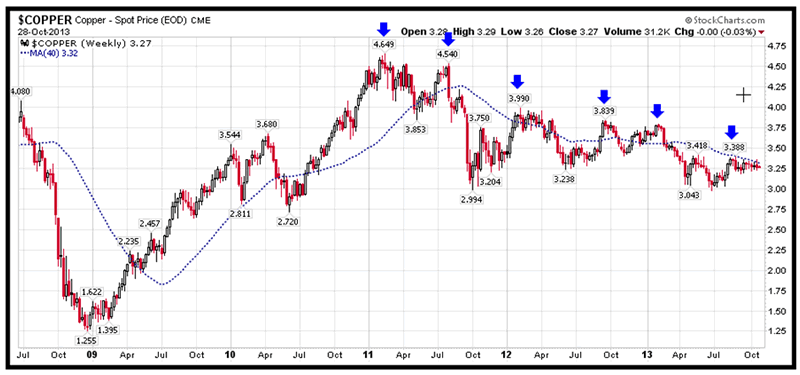
Source: www.stockcharts.com
Elsewhere in the hard assets universe, it is noteworthy that up until now, crude oil has been one of the strongest commodities. However, even here, we suspect that the price of crude will probably remain range bound for the foreseeable future.
Under this scenario, the upstream energy firms will probably disappoint investors, so they should be avoided for now. If anything, investors who are itching to invest in energy may want to consider the integrated oil companies and the dominant pipeline businesses.
Finally, in the agricultural space, prices are still under pressure and this is not the time to go bottom fishing! If anything, the prices of coffee and corn have resumed their southbound journey and both items are now trading at multi-month lows.
Bearing in mind the ongoing free-fall in the prices of various agricultural commodities, investors should refrain from committing capital to farm equipment manufacturers and fertilizer stocks.
In summary, after a glorious secular bull market, the commodities complex is probably in the early to middle innings of a multi-year downtrend. Accordingly, we currently have no exposure to this sector and unless the price action improves, we will continue to watch the show from the sidelines.
PRECIOUS METALS – Contrary to the gold bugs, precious metals are now in a secular downtrend and this is not the time to swim against the tide.
There can be no doubt that the prices of gold and silver benefited immensely during the decade long bull market; however, that party ended in 2011. If you review the price charts objectively, you will note that both gold and silver topped out over two years ago and their prices have fallen since then. Unsurprisingly, this downtrend has stunned most gold bugs as well as their cheerleaders and these folk are still in denial. According to the perma-bulls, the primary uptrend in the metals is still intact and the bears are simply oblivious to the superb fundamentals! Moreover, according to these gold bugs, each and every price slide in the metals (whether minor or major) is a great buying opportunity to accumulate even more ‘real money’ at bargain prices.
It goes without saying that everyone is entitled to their opinion, but from our perspective, blind faith is not a sound investment strategy. In fact, ignoring the price action and buying every dip is a sure shot way to the poorhouse.
If you set aside your biases and review Figure 6, you will note that the price of gold peaked in September 2011 and after a multi-month trading range, we saw a breakdown in April 2013. In our view, this dramatic plunge in spring confirmed the death of the secular bull market and opened up the possibility of a multi-year downtrend. Furthermore, you can see that gold is currently trading beneath the 40-week moving average and this is a bearish omen.
Figure 6: Gold (weekly chart)
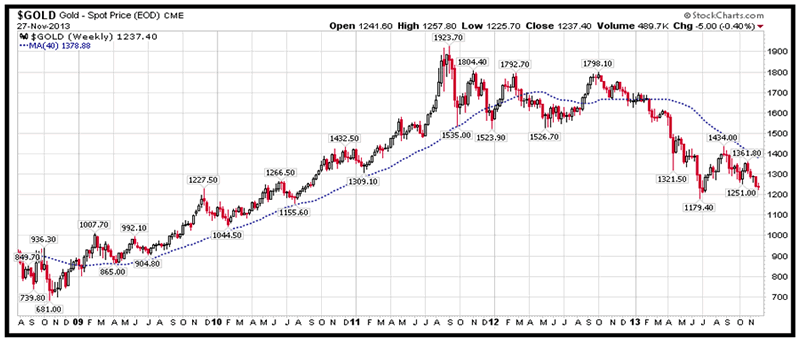
Source: www.stockcharts.com
In addition to gold, silver’s technical setup is also bearish and it appears as though the path of least resistance remains down.
Remember, unlike businesses, farmland and investment real-estate, gold and silver are largely unproductive assets and the ongoing recovery in the economy is a major headwind for the metals. Make no mistake, despite what the gold bugs may tell you, the prices of gold and silver do not always go up. Thus, ‘buy and hope’ is not a prudent methodology.
Finally, when reviewing the price action in the mining stocks, we cannot help but think that the trend remains down and if anything, there is a real risk that prices may fall below the recent lows.
Bearing in mind the above, we currently have no exposure to bullion or the related mining stocks and unless the price action improves, we will continue to avoid this sector.
Puru Saxena publishes Money Matters, a monthly economic report, which highlights extraordinary investment opportunities in all major markets. In addition to the monthly report, subscribers also receive “Weekly Updates” covering the recent market action. Money Matters is available by subscription from www.purusaxena.com.
Puru Saxena
Website – www.purusaxena.com
Puru Saxena is the founder of Puru Saxena Wealth Management, his Hong Kong based firm which manages investment portfolios for individuals and corporate clients. He is a highly showcased investment manager and a regular guest on CNN, BBC World, CNBC, Bloomberg, NDTV and various radio programs.
Copyright © 2005-2013 Puru Saxena Limited. All rights reserved.
© 2005-2022 http://www.MarketOracle.co.uk - The Market Oracle is a FREE Daily Financial Markets Analysis & Forecasting online publication.



